 | ||
The Ennead or Great Ennead was a group of nine deities in Egyptian mythology worshipped at Heliopolis: the sun god Atum; his children Shu and Tefnut; their children Geb and Nut; and their children Osiris, Isis, Set, and Nephthys. It rose to importance in Dynasties V and VI and remained prominent in Egypt into its occupation by the Macedonian Ptolemaic dynasty established by Alexander the Great's successor in the area, Ptolemy I.
Contents

The Great Ennead was only one of several such groupings of nine deities in ancient Egypt and its claims to preëminence by its Heliopolitan priests were not respected throughout Egypt. As close as Memphis (also within modern Cairo), the priests of Ptah celebrated him as superior to the Nine.
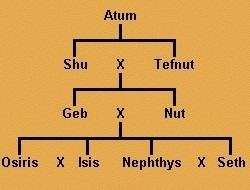
Ennead 1 6 on beauty
Names
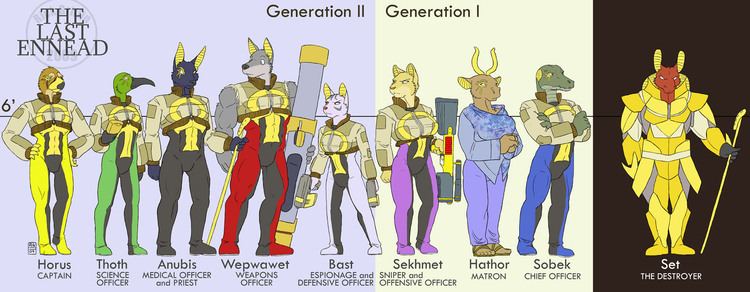
Ennead is borrowing via Latin of the Greek name Enneás (Ἐννεάς), meaning "the Nine". The term was a calque of the Egyptian name, written Psḏt and also meaning "the Nine". Its original pronunciation is uncertain, since hieroglyphs do not record vowels, but Egyptologists conventionally transcribe it as Pesedjet.
History
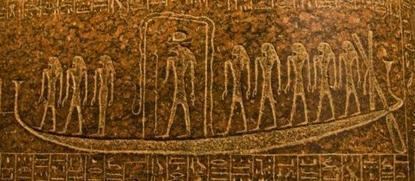
The ancient Egyptians created several enneads as their unification under Dynasty I brought numerous local cults into contact with one another. The Pyramid Texts of Dynasties V and VI mention the "Great Ennead", the "Lesser Ennead", the "Dual Ennead", and the "Seven Enneads". Some pharaohs established enneads that incorporated themselves as gods. The most notable case is Seti I of Dynasty XIX, whose temple at Redesiyah celebrated an ennead of six major gods and three deified forms of himself. In the Calendar of Lucky and Unlucky Days, the ennead mentioned may reference the Pleiades.
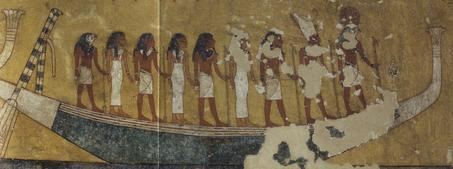
The most important was the "Great" or "Heliopolitan Ennead" of Awanu (Egyptian: I͗wnw), known under the Greeks and Romans as Heliopolis. It celebrated the family of the sun god Atum and thrived from the Old Kingdom to the Ptolemaic period.
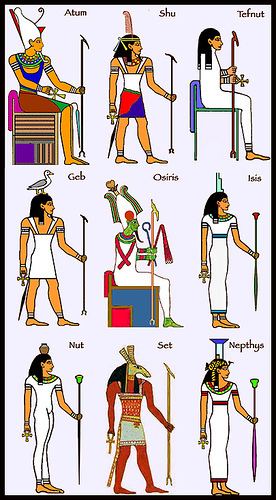
Its development remains uncertain, although it appears to have first appeared when Ra's cult—supreme under Dynasty V—declined in importance under Dynasty VI. Egyptologists have traditionally theorized that the Heliopolitan priesthood established it to establish the preëminence of Atum over the others, incorporating some major gods in lesser positions and omitting others entirely. The most prominent of such deities was Osiris, god of vegetation and the afterlife, who was incorporated into the Ennead as Atum's great-grandson. However, in the 20th century, some Egyptologists question the whole scenario. After the Great Ennead was well established, the cult of Ra—identified with Atum—recovered much of its importance until superseded by the cult of Horus. The two were then combined as Ra–Horus of the Horizons.
Myths
According to the creation story of the Heliopolitan priests, the world originally consisted of the primeval waters personified as Nun. From it arose a mound, separately identified by the Memphite priests as Ptah. Upon the mound sat the self-begotten god Atum, who was equated with the sun god Ra. Bored and alone, Atum either spat or masturbated, producing air personified as Shu and moisture personified as Tefnut. (In other accounts, Ra produced these two by mating with Iusaaset.) The siblings Shu and Tefnut mated to produce the earth personified as Geb and the nighttime sky personified as Nut. These siblings engaged in continuous copulation until separated by their father Shu, who lifted Nut to her place in the sky, conceived by the Egyptians as a firmament. Geb and Nut were the parents of Osiris and Isis and of Set and Nephthys, who became respective couples in turn.
